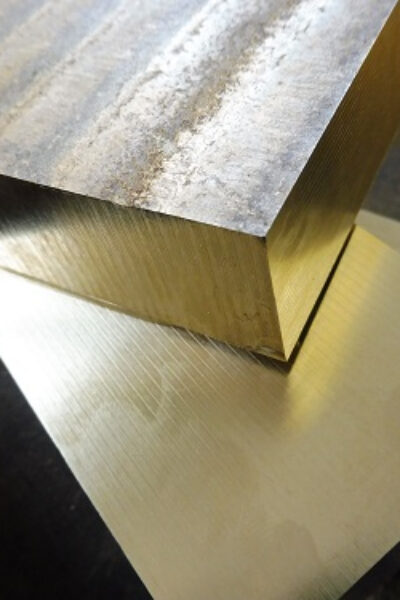Products
Aluminum bronze - the high-end copper alloy
Aluminum bronzes offer ideal properties
Many industries already benefit from the excellent sliding properties of ALBROMET aluminum bronzes. In general, aluminum bronzes combine very good, steel-like strength values with high corrosion resistance to water, seawater, acids and chemicals. ALBROMET offers a wide range of aluminum bronzes with hardness values of 190 – 310 HB and a modulus of elasticity of 110 – 127 kN/mm2. This makes them the ideal materials for sliding elements such as plain bearings, guide bushes, sliding plates or pins.
Even if the name suggests otherwise, aluminum bronzes are copper alloys. They contain aluminum as the main alloying element, usually in the range of 5 – 15%.
This main alloying element gives them their name. Aluminum bronzes can contain other alloying elements such as iron, nickel, manganese or zinc in lower percentages in order to improve certain properties.

ALBROMET aluminum bronzes, properties and characteristic values:

You can find all characteristic values here:
The detailed data sheets for all alloys can also be found in our media library.
We supply aluminum bronzes as semi-finished products according to your wishes and shape
The aluminum bronzes are available in stock as cast, pressed or forged semi-finished products in various shapes (round, tube, plate) and dimensions. Convince yourself of our comprehensive product range.
ALBROMET supplies semi-finished products tailored to your desired dimensions. At the same time, thanks to our extensive CNC machinery, we can also produce finished parts from all the aluminium bronzes mentioned above according to your drawings from a quantity of 1. This helps to relieve your production and minimize procurement costs.
Please ask for a non-binding offer!
Aluminum bronze has particularly good corrosion resistance
The aluminum bronze alloys ALBROMET-A200, A220Ni and A260Ni offer high corrosion resistance in many environments, especially with pH values > 4.5.
Due to its good resistance to corrosion, aluminum bronze is often used in applications in the chemical industry, in seawater environments or in applications with a high pH value.
Corrosion protection is provided by the addition of aluminum, which forms a protective oxide layer on the surface.
This oxide layer is particularly stable and resistant, even in basic or alkaline environments.
Standard brass alloys, on the other hand, are prone to intercrystalline corrosion or dezincification in chlorinated water or in water with a high oxygen and carbon dioxide content.
This does not apply to aluminum bronzes.
Alloys with an increased nickel content such as ALBROMET-A220Ni and ALBROMET-A260Ni offer very good resistance to cavitation due to their higher toughness.
Aluminum bronzes with food certificate
The following ALBROMET aluminum bronzes and guide bushings have been declared safe for direct contact with food by an independent testing institute in accordance with EU Regulation 1935/2004. These alloys are therefore ideal for use in the food technology and packaging industry and combine high wear resistance with very good thermal conductivity.
Answers to frequently asked questions
The number after the “A” stands for the average hardness value measured in Brinell for aluminum bronzes.
Due to its composition and surface properties, aluminum bronze reduces the sliding friction between the partners. Aluminum bronze and steel do not react chemically with each other and therefore do not form a bond that could lead to adhesion. The natural lubricating properties of aluminum bronze further reduce friction between the contact surfaces. The high values for hardness and strength also make them resistant to wear. This helps to ensure that the surfaces remain smooth and reduces the risk of adhesion (seizure) between the materials.
If the hardness of the selected aluminum bronze is lower than that of steel, it is defined as the wear partner in the friction system.
Aluminum bronze dissipates heat efficiently, which prevents the sliding partners from overheating.
By dissipating heat, the probability of damage due to thermal stress during sliding friction is also reduced.
Sufficient lubrication is required depending on the load.
However, the emergency running properties of aluminum bronze are very good.
Aluminum bronzes are usually produced using traditional smelting processes and further processing of continuous cast billets in forges and pressing plants.
ALBROMET sources its aluminum bronzes mainly in Europe and North America.
Various dimensions of round, tubular and flat material are kept in stock.
These are cut to size at ALBROMET at short notice.
The recyclability of aluminum bronze is very good, similar to that of other copper alloys.
They consist of a mixture of metals that can be separated and recycled relatively easily.
Aluminium bronze is usually recycled by melting the material in specialized plants.
During this process, the aluminum bronze alloys are separated from other metals that may also be contained in the alloy.
The recycled material can then be processed into new aluminum bronze alloys or other products.
Recycling aluminum bronze conserves natural resources as fewer primary raw materials are required.
In addition, the production of aluminum bronze from recycled material requires less energy than the production from primary raw materials.
ALBROMET aluminum bronzes do not contain any hazardous substances that are on the REACH candidate list (SVHC list). A lead content is not detectable (< 0.05 mass percent). This means that the copper alloys are REACH and RoHS compliant. You can find more information here.
In addition, nickel-free aluminum bronzes offer potential for more environmental and resource protection.
Aluminum and the other elements in aluminum bronzes, such as iron and manganese, are frequently available and can be mined and processed more efficiently and in a more environmentally friendly way than nickel.
Aluminum bronzes without nickel are often easier to recycle and cause less environmental pollution during recycling.
The permeability of our ALBROMET-A220Ni is 1.07 H = 100 Oe.
This value is so low that it is practically non-magnetic and non-sparking.
This material can come into contact with seawater and can therefore be used in the oil & gas industry.
Aluminum bronzes are corrosion-resistant in alkaline media with a pH value of > 7. They are often used in applications involving alkaline solutions or alkaline media, such as in the chemical industry, in seawater environments or in applications with a high pH value. The addition of aluminum to copper alloys forms a protective oxide layer on their surface, which protects them from corrosion. This oxide layer is particularly stable and resistant, even in basic or alkaline environments. However, the resistance depends on the specific composition of the alloy, the temperature, the concentration of the basic solution and the duration of exposure.
In acidic media with a pH value between 7 and 4.5, aluminum bronzes exhibit good corrosion resistance.
However, they can be sensitive to strong or oxidizing acids such as hydrochloric acid or sulphuric acid.
The concentration of the acid plays an important role here.
Higher temperatures increase reactivity and accelerate corrosion.
The exact composition of the aluminum bronze alloy influences its corrosion resistance.
Aluminum bronzes have a high strength, which makes them robust and resistant to mechanical stress. Carbide tools are very suitable for machining aluminum bronzes. Diamond tools offer the best performance, especially for demanding machining operations. High-speed steel (HSS) tools can be used, but are less effective than carbide or diamond tools. Adequate cooling and lubrication during machining is essential. This helps to keep the tools cool, improve surface quality and extend tool life. With the right techniques and tools, precise and high-quality machining results can be achieved.
Get in touch with us!
We will advise you competently and personally.


